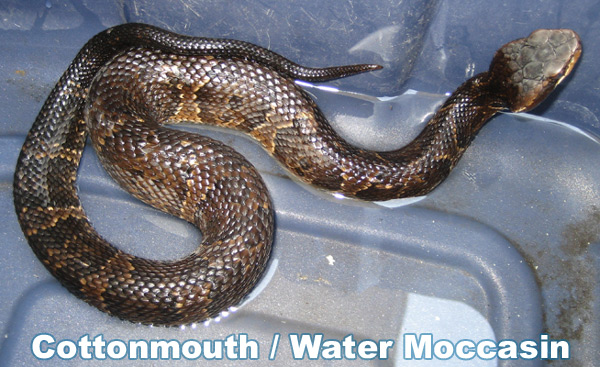- info@wildlife-removal.com
Call us for help in your town
Wildlife Removal Education
How to Get a Snake Out of a Pool
The best way is to just pick it up, at a distance, with your pool skimmer, and let it go outside. If that's not possible, you need to identify the snake, and if it's safe, remove it by hand, with a glove. If that's not possible,
you may want to call a pro to help you.
Click here for my nationwide list of 100's of snake removal experts serving all 50 states.
Most people have to steel themselves, mentally and emotionally, to remove an unknown species of snake from their pool. Snakes can swim, and while they aren’t enjoying your floating apparatuses as much as you would, they are enjoying your pool for drinking and cooling off. Just as a little chlorinated water doesn’t hurt us, it doesn’t do much to a snake either. A snake breathes with lungs and not gills so adding chemicals to your water will not affect the reptiles unless the toxins are so potent you can’t stand to be in your pool, either. You have a pool, so you must like to swim, and it makes sense to avoid any methods that make your pool completely unusable. Not only does that ruin your summer fun, but you can do serious damage to your pool liner and filtration system.

All species need water to survive, and snakes are no different. Reptiles are drawn to water, and many can sense the liquid from a significant distance away. Sometimes a snake will enter a pool for a drink or for a swim and will fail to realize the lip of the pool will prevent exiting. The reptiles have little choice but to keep swimming until they ultimately exhaust themselves and drown. Getting a snake out of a pool isn’t a hard task if you have a pool skimmer handy. This long-handled tool is ideal for fishing out unwanted objects. Snakes that are still alive and are trapped in a pool can also be guided out onto a slanted board. But now that you have the snake out of the pool, what are you going to do with it?
If you are not a snake connoisseur, it is wise to enlist the aid of a professional to help you remove the snake. Many fallacies exist when it comes to distinguishing venomous snakes from non-venomous snakes, and there is no way to be completely certain unless you have experience with reptiles. A trained professional will know what kind of snake is by your pool, and usually the expert will have some snake tongs handy for easy snake removal.
If you prefer to catch the snake on your own, there are a variety of ways to go about it, but the safest, hands-free way involves the use of a professional grade snake trap. Many snake traps on the market do not work, so be sure the one you purchase has been used successfully by wildlife professionals. A trap allows you to catch the snake without the use of brooms, buckets, garbage bins, or pillowcases. A trapped snake can be safely relocated to an area more suited to its needs.
Now that you’ve had a snake in your pool, you should consider changing some of the attributes around your home that allowed the snake in to begin with. Most states require a fence around a pool to prevent small children and pets from falling in. A fence that is solid and flush with the ground will help you keep out slithering serpents, but make sure your fence is high enough and smooth enough to prevent a snake from crawling over it (yes, they can do that!). Covering your pool at night with a pool cover will help prevent snakes from entering the pool when no one is around. Keep low-lying vegetation and mulch away from the pool area, and keep your yard mowed. A cool, secluded place like a hedgerow is the perfect place for a snake to escape the heat of the day. Flowers around a pool, though picturesque, provide the same safe haven as the hedgerow. Cosmetic changes around the pool are quick and easy, and often make the biggest difference when trying to keep snakes out of the water.


















